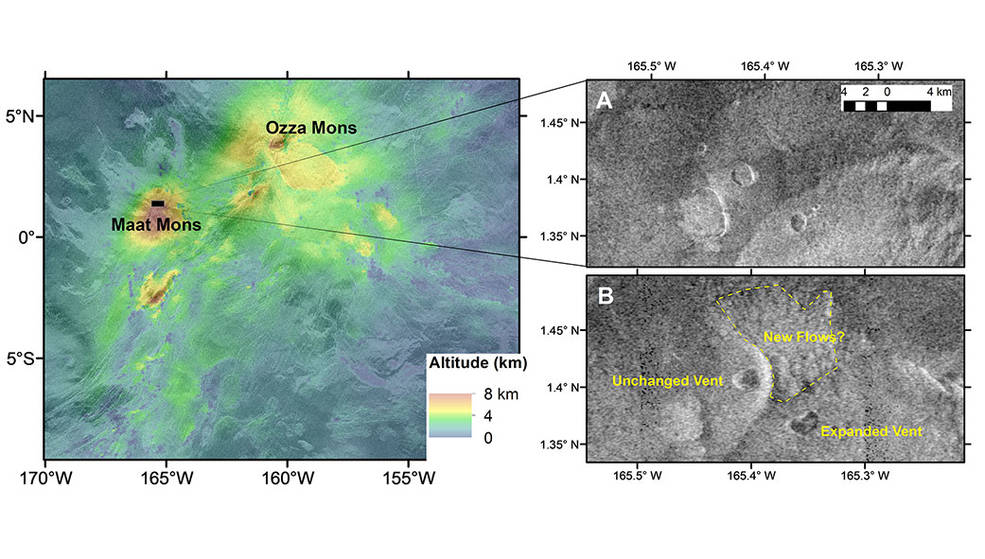Scientists have found evidence of active volcanoes on Venus: Here’s why it is important

Computer-generated 3D model of Venus surface. Photo: NASA
For the first time ever, scientists have found direct evidence that Venus, often called Earth's twin, has active volcanic activity. The latest findings were published in the journal Science on March 15, and was presented at the 54th Lunar and Planetary Science Conference in Texas, US.
You must be wondering why volcanic activity on a faraway planet - that is not Mars - important.
Well, there's a reason why Venus is called Earth's twin and why scientists are studying whether volcanic activity is ongoing on the planet or is ancient history.
To understand the importance, let's first look into what the latest findings say.
What's new?
- It's old news that Venus is covered in volcanoes. But for decades, scientists have been trying to find out whether these volcanoes were active or not.
- Researchers have been trying to find out whether Venus's volcanoes erupted millions of years ago, whether they erupt every few 100 years or decades or years.

- And the latest study found one instance where a volcano erupted in less than a year's time.
- The observations revealed a volcanic vent on Venus changing shape and significantly increasing in size in less than a year.
How was the evidence found?

Research often takes decades. And this one was no different.
- The recent findings are based on examining radar images of Venus's surface taken by NASA's Magellan from 1990-92.
- Scientists had to manually sift through the images taken nearly 30 years ago to find the evidence.

- Herrick calls it "a needle-in-a-haystack search with no guarantee that the needle exists."
- The team believes that the changes the Magellan photos witnessed in 1991 may have had a lava flow similar to the 2018 Kilauea eruption in Hawaii.
Where on Venus? The researchers observed changes in Atla Regio, near Venus’s equator, where there are two of the planet’s largest volcanoes - Ozza Mons and Maat Mons.
- The volcanic event was found associated with Maat Mons, which changed between February and October 1991.
However, there are limitations to the study:
Scott King, a geophysicist at Virginia Tech University questioned whether the images were strong enough to provide evidence.

- You see, the image quality 30 years ago wasn't great, nothing compared to what they are today. So, sifting through poor quality images is a difficult task.
- The researchers do acknowledge the limitation, but their argument is that there is no other type of volcanic activity known to them on Earth that could cause the kind of changes they observed on Venus.
- There are questions still looming whether the changes observed to the landscape in the two Magellan photos were shaped by volcanic activity or maybe by other events such as a Venus-quake.
Why is this important?

Now, answering the most important question: Why is it important for us Earthlings to know what's happening on Venus, which unlike Mars is not even on Elon Musk's list of to-do things?
- Venus is called Earth's twin because it is the same in size and density. So, it has always interested researchers why Earth went on to become hospitable to life when Venus went in the opposite direction.
- There have been speculations about whether Venus once had some form of water on its surface, with some studies saying yes, while others saying no.
- Scientists say learning more about Venus's volcanic activity can help unravel the planet's evolution as it is today and even that of Earth's; basically, Earth's history billions of years ago.
- Researchers also study volcanoes, especially active ones, to understand a planet's interior, what shapes its landscape, its evolution, and its impact on hospitability.
Also, there are a few missions in the pipe to Venus that NASA is planning to send, including VERITAS, of which the current researchers are a part of. So far, funding crunch and other factors have turned out to be hurdles for the mission to take off.
Sending missions to Venus to explore its surface is pretty difficult due to the sweltering temperatures - 450 degree Celsius. The most reliable data so far has come from the Magellan mission from 30 years ago.

